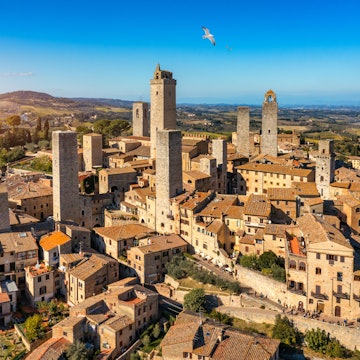

Piazza dei Miracoli with the iconic Leaning Tower of Pisa. Gabriele Maltinti/Shutterstock
Every day, hundreds of people from all parts of the world make the pilgrimage to Pisa’s Piazza dei Miracoli, raising their palms toward the sky to worship the world’s best-known architectural mishap. The city’s famously tilting marble tower has long been Pisa’s main draw, especially since the algorithm gods recognized that posing below the gravity-defying structure is a traveler’s ritual. Yet, meme-inducing Pisa is more than its 12th-century flawed campanile – there is much to discover, if you choose to lean into it.
Expanding on the banks of the Arno River, Pisa flourished in the Middle Ages as one of Italy’s most powerful maritime republics, rivaling Genoa and Venice in the race to dominate the Mediterranean. The wealth acquired during Pisa’s golden age transformed the city into one of the country’s most important centers for scientific research, a heritage maintained by its 700-year-old university.
Students still make up a significant portion of Pisa’s population, breathing new life into the city’s historic core, a network of walkable streets linking art galleries, museums and market squares branching out on both sides of the Arno. With a lively bar scene and many traditional restaurants to choose from, there is plenty to keep you busy. Plan your trip to Pisa with this guide for first-time visitors.

When should I go to Pisa?
As for much of Tuscany, the best time to visit is during the shoulder season, meaning right before or after the middle of summer. July and August are the peak holiday season in Italy, with prices soaring together with temperatures. Late spring and early autumn usually guarantee the ideal balance between sunny skies and manageable crowds.
This said, tourism in Pisa is very much concentrated around a limited number of sites. You won’t feel pushed around when joining local families for pleasant strolls on the lungarni (the riverbanks) on warm summer nights, nor will you find lines outside restaurants and museums, like in Florence.
Seasonality shouldn’t stop you from visiting. There’s enough to do indoors to justify a winter visit and the proximity to the sea makes beach escapes simple if you are looking for a break when the weather gets hot.

How much time should I spend in Pisa?
Of the millions of travelers who land every year in Pisa’s Galileo Galilei airport, Tuscany’s busiest, only a minority extends their stay beyond the few hours spent in the UNESCO-inscribed Piazza dei Miracoli, where the iconic torre pendente precariously stands.
By spending a couple of days in the city, you can dedicate some time to discovering the city’s rich past, either through art or archaeological remains. For instance, spend a morning browsing through the excellent collection of medieval art found in the Museo Nazionale di San Matteo or discover Pisa’s relationship with the sea at the Museo delle Navi Antiche di Pisa.
Move on to something more contemporary by visiting the exhibitions at Palazzo Blu or going in search of Keith Haring’s Tuttomondo mural, on the southern side of the Arno, before a stroll along the river with a gelato cone from Gelateria De' Coltelli in hand.
If you have more time you can exit the city center and spend a day in the vast nature reserve of San Rossore, best explored on a bike available for rent at the visitor center. And for some more outdoor action, you can hike up Monte Pisano, the mountain range that divides Pisa from Lucca, or head to Tirrenia for a day at the beach.
Is it easy to get in and around Pisa?
Pisa’s Galileo Galilei airport is serviced by many low-cost airlines, connecting to cities in Europe and beyond. From the airport, the Pisa Mover monorail takes you to the city center in a matter of minutes (tickets €6.50/US$7.40). The city itself is easly explored on foot.
Regional trains to other Tuscan destinations, including Florence and Lucca, depart frequently from the main railway station, Pisa Centrale. You can buy all tickets online via trenitalia.com and there is no need to book in advance.

Top things to do in Pisa
Explore the marble treasures of Piazza dei Miracoli
Besides the famous campanile, the UNESCO-listed Piazza dei Miracoli (Square of Miracles) hosts some of Pisa’s most impressive pieces of historic architecture. After climbing the 251 steps of the leaning tower, which took almost two centuries to complete starting from 1173 and was stabilized only in the 20th century, take some time to explore the thousand-year-old Duomo – built with the spoils of a 1063 raid on Palermo – and the Baptistery with its stunning acoustics.
Continue to the Camposanto to admire the restored Triumph of Death fresco, a meditation on mortality by Buonamico Buffalmacco recovered from wartime ashes. The museums of the complex – Museo dell’Opera del Duomo and Museo delle Sinopie – house the original sculptures that once adorned these sacred spaces and the rare preparatory sketches that laid their foundation, offering a window into centuries of Pisan artistry.
Discover Pisa's maritime history
Pisa’s role as a maritime powerhouse was known long before an astonishing discovery connected to its seafaring history was stumbled upon in 1998. Eight remarkably preserved vessels, dating from the 3rd century BCE to the 7th century CE, were found near a railway station, opening a new chapter of research into the city’s past. The Roman ships are now the central exhibits of the Museo delle Navi Antiche di Pisa, surrounded by over 800 artifacts that trace Pisa development as a city-state on the Mediterranean shores.

Admire medieval and Renaissance Tuscan art
Many visitors miss the Museo Nazionale di San Matteo, a short walk east of the city center. Showcasing one of Italy’s most valuable collections of medieval and Renaissance art, this atmospheric museum tracks five centuries of Tuscan creativity.
Paintings and sculptures spanning the 12th to 16th centuries, including works by Masaccio, Beato Angelico and Benozzo Gozzoli are exhibited in the halls of a former 11th-century Benedictine convent peacefully overlooking the Arno River. Despite its cultural value, the museum is often deserted, allowing for the quiet contemplation you’ll start missing as soon as you visit Tuscany’s other big art institutions.
Take a stroll in Borgo Stretto
Leave behind the monumental grandeur of Piazza dei Miracoli for a taste of daily Pisan life, by heading towards Borgo Stretto, the most elegant artery of the city’s historical center. Join locals on their passeggiata (afternoon/evening stroll) in this narrow street lined with 15th-century buildings and a long arcade, where merchants and nobles crossed paths in medieval times. A few extra steps will take you to Piazza delle Vettovaglie, Pisa’s market square since the 16th century.

Go for a cycle in San Rossore
Officially known as the Parco Naturale di Migliarino, San Rossore, Massaciuccoli, the 23,000-hectare reserve expanding 5km (3 miles) west of Pisa makes for an excellent day out of the city. Rent a bike at the San Rossore visitor center and access the Mediterranean pine forests through the scenic paths that intersect the park. The heart of the reserve is the Tenuta di San Rossore, originally established as the private hunting grounds of the Medici family, who ruled over Tuscany. Many animals still roam the area – you could encounter horses, boars and deer as you make your way toward the coast.
Walk the city walls
Erected around the same time as the leaning tower, the defensive walls that once encircled Pisa are among the oldest preserved city walls in Italy. There are various entry points to climb the 11m (36ft) structure snaking through the city, including Torre Santa Maria in Piazza dei Miracoli, which is wheelchair accessible. Once on top, you can walk the 3km (1.9-mile) walls in search of the best viewpoints over the city.
Check out Vasari’s Palazzo della Carovana
Legendary Tuscan architect Giorgio Vasari designed the elegant Palazzo della Carovana in 1560, to house the headquarters of the Knights of St Stephen. The whole facade is covered by intricate depictions of allegorical figures produced using the sgraffito technique. Today, the palace houses the prestigious Scuola Normale Superiore, one of Italy’s top universities.

My favorite thing to do in Pisa
A 15-minute drive from Pisa’s city center takes you to the town of Calci, where the monumental Certosa di Calci – a 15th-century charterhouse immersed in nature, once inhabited by a community of self-sufficient monks – has been converted into the fascinating Museum of Natural History run by the University of Pisa.
After visiting the museum, you can climb up to the Fortezza della Verruca, the abandoned castle whose ruins rest on top of the Monte Pisano ridge overlooking the Tyrrhenian coast. It’s a steep hike to the top, but you’ll be rewarded by spectacular views of the mountains descending toward the sea.
How much money do I need for Pisa?
Pisa tends to be slightly cheaper than more popular Tuscan destinations, such as Florence and Siena. As for other cities, prices inflate near big sights – expect to pay more to eat in the surroundings of Piazza dei Miracoli. Besides this, many cultural sights are free or low-cost. You can admire much of the city’s architecture without paying, and access to the city walls or the Museo Nazionale di San Matteo only costs €5 (US$5.65).
Here are some examples of average costs you might expect:
Hostel bed in a dorm: €25–40 per night (US$28–45)
Room in a budget/mid-range hotel: €70–150 per night (US$77–170)
One-way public transport ticket (bus): €1.50 (US$1.70)
Cappuccino at a local cafe: €1.50–2.50 (US$1.70–2.80)
Pizza margherita for one: €7–10 (US$7.95–11.35)
Dinner for two at a mid-range restaurant: €60–90 (US$68–102)
Glass of local wine or a beer: €4–6 (US$4.50–6.80)
What’s the best way to get to Piazza dei Miracoli?
If you are arriving by train to Pisa and planning to visit Piazza dei Miracoli and the leaning tower, it’s best to get off at the city’s second railway station, Pisa San Rossore (one stop before Pisa Centrale if you are coming from Florence). From there, Piazza dei Miracoli is steps away.

What are the closest beaches to Pisa?
Marina di Pisa and Tirrenia are a 20-minute drive away from the city center. Larger and more popular beaches are found a little further north, in Torre del Lago, Viareggio and Lido di Camaiore. During the summer, most beaches on the Tuscan coast are privately managed. Unless you find a spiaggia libera (freely accessible beach), you’ll need to rent chairs and an umbrella to spend the day on the sand.
What's the best way to explore the rest of Tuscany from Pisa?
If you're flying into Pisa to explore the rest of Tuscany, you can either rely on public transport or rent a car at the airport. If you are interested in cities and the region’s artistic heritage, you can easily move around by train without the need to plan too much ahead. If you want to visit the countryside, a car is essential. Major rental companies operate in the airport – book well in advance to get the best price, especially if you are visiting in the high season (June to September).
Can I drive to Pisa?
Much of the inner city is a limited traffic zone, so you won’t be able to access it by car. Keep your eyes open for the ZTL (zona a traffico limitato) signs, marking the border of the areas exclusive to vehicles with special permits. If you cross the ZTL boundary, expect a hefty fine.
















